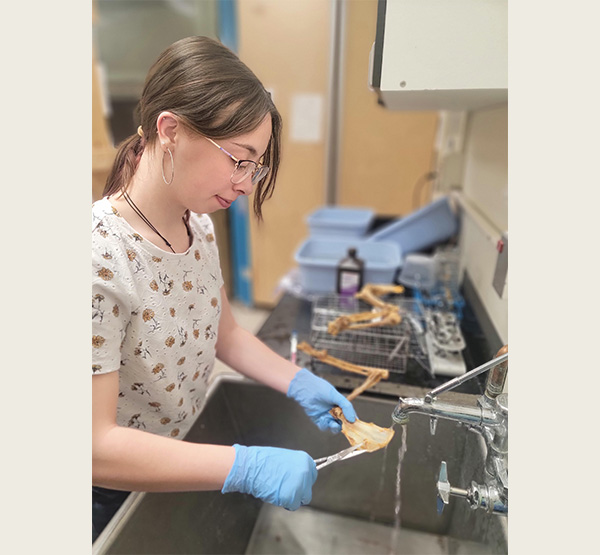Miami University students help prepare new specimens for display at the Hefner Museum of Natural History
A polar bear and other creatures not commonly exhibited are being incorporated into existing collections
Miami University students help prepare new specimens for display at the Hefner Museum of Natural History

Cleaning a porcupine, other specimens
Students work and volunteer at the museum on a wide range of projects, including the sometimes tedious work of cleaning specimens. Some can be particularly challenging. One of the most difficult to clean was the African crested porcupine, said Jordan “J” Heekin, a rising junior majoring in Political Science with a minor in Classics.
“You can imagine the inherent challenges of cleaning individual porcupine quills,” Heekin said. “One of the most interesting parts of the job is to be able to see up close some of the amazing qualities that make each animal so specially adapted to their way of life."
Heekin discovered the Hefner Museum by chance last fall while looking for a class in Upham Hall.
“After having a fun conversation with Steve about some of the specimens, he asked me if I would like the opportunity to work with them,” recalled Heekin, who volunteered last fall and plans to do so again in future semesters.
“Even though most of the specimens I cleaned required a very similar technique, they were all interesting because they are each different animals, which have all been preserved in unique ways,” Heekin said.
Sullivan provides guidance to the students on how to properly clean the different specimens, ranging from a spur-winged goose to an Australian possum.

Quarantine: a necessary step
The polar bear specimen was put in quarantine immediately after its arrival.
When new specimens come to the museum, they are quarantined to ensure they don't carry any pests, such as clothes moths, that might destroy the skins.
“Specimens are subject to a wide range of agents of deterioration — UV light, fluctuating humidity, touching,” Sullivan said. “Biological specimens are additionally subject to insects that can consume them, and these can infect existing collections.
"So, we need to isolate anything new to ensure it doesn't have any pests,” he said, noting that for the same reason, the museum excludes food from the galleries. “Even little crumbs or drops can attract pests that then eat our specimens.”
During quarantine, Sullivan said, "students learn how to identify and safely treat 'agents of deterioration,' clean, groom, and restore mounts, repair and re-scupt support bases and many other skills that they will use in their future careers."
Throughout Brickley's life, he collected many species that are often ignored by the typical collector, Sullivan said. He also donated an arctic fox that Hefner may exhibit alongside the polar bear.
Hefner doesn’t typically accept donated specimens but did in this case.
“Though the Hefner is a key component of organismal education at Miami, and an important connection between the university and the broader public, we have very little space — both for scientific specimens as well as exhibitions,” Sullivan said. “I have turned down charismatic and informative species like musk ox, giraffes, black swans, and more, simply due to lack of space.”
Sullivan has been working with students to prepare a space for the polar bear, refurbish its base, and create a new exhibit around it. They are aiming to have it go on display during fall semester.

Working with bones
Victoria Gerencser, a rising sophomore with a double major in Zoology and Environmental Science, started working at the museum last November.
“I wanted to be involved in something beyond just my clubs and classes and knew about the Hefner Museum,” she said. “I loved being at the museum and knew Steve already, as my parents and I had met him by accident on a college tour."
Gerencser said working there not only gives her great hands-on experience but also a “fun fact” to share with others.
She has cleaned bones, reassembled bones, and worked on refurbishing the polar bear base.
“For cleaning bones, I have done a groundhog skull, a gazelle, a few felines, two vulture skulls, and started a snapping turtle. I have also reassembled the groundhog skull,” she said.
“I also enjoy identifying the bones of the animals I clean as it allows me to get a hands-on anatomy lesson. I find it cool to compare the homologous bones of other animals to my own bones.”
Gerencser loves her museum job and hopes to continue working there for the next three years.
“It is something that not everybody gets to do,” she said, adding that it’s a nice break from schoolwork. “I enjoy getting hands-on experience and learning outside of the classroom."
Gerencser isn’t sure yet what she wants to do after graduation but is considering going to graduate school for marine biology or doing something conservation related.
“I’ve also always wanted to open my own animal rehabilitation center or sanctuary,” she said. “No matter what, I know I want to work with animals and make a difference.”
Interested in learning more about the Hefner Museum of Natural History? Visit the website for more information.
Visit Museums Miami to learn more about all of Miami ‘s museums and other special collections.
Established in 1809, Miami University is located in Oxford, Ohio, with regional campuses in Hamilton and Middletown, a learning center in West Chester, and a European study center in Luxembourg.